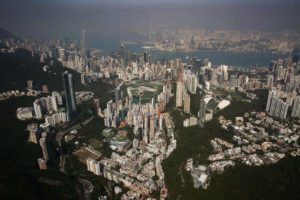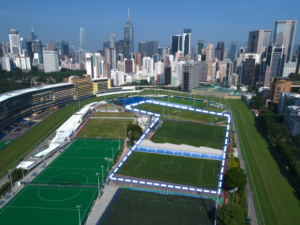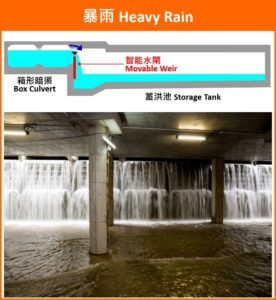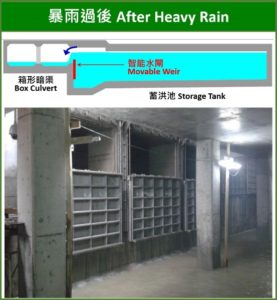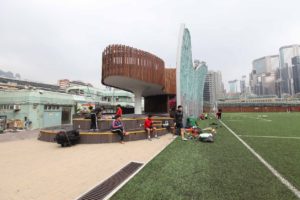Underground Stormwater Storage Scheme
The low-lying Happy Valley area at Hong Kong, surrounded by hilly terrain, faces frequent flooding during heavy rains. In order to tackle the flooding issue with minimal disturbance to the public and commercial activities at one of the most traffic congested area in Hong Kong, the Drainage Services Department (DSD) of the Hong Kong Special Administrative Region has developed an innovative flood protection scheme.
The scheme included the construction of a gigantic underground storage tank, with a capacity of 60,000 m3, beneath the existing Happy Valley Recreational Ground which temporarily stores excessive storm-water during heavy rains before discharging to downstream drainage system so as to mitigate flood risks.
One of the highlights of the project is that the storage tank is situated at the central area of the Happy Valley Racecourse, one of Hong Kong’s famous attractions. The project team had put in a lot of efforts to ensure no disturbance to the racing track during construction.
Overview of Happy Valley & Wan Chai Area
(Happy Valley Recreational Ground is at the middle of the photo closer to the sea)
The storm-water storage tank is in an L-shape and located underneath the existing Happy Valley Recreational Grounds, beneath 5 sports pitches. Construction of the storage tank was split into two phases so that some of the pitches would remain available to users while the rest were temporarily closed to facilitate the construction works.
The L-shaped storm-water storage tank under Happy Valley sports pitches
The original box culvert ran along the perimeter of the racecourse. To make it work with the storage tank, the original box culvert was diverted and a new 650 m long twin-cell box culvert was constructed down the middle of the racecourse. Fifteen intelligent movable weirs were installed between the box culvert and the storage tank to control the flow of storm-water into the latter.
The movable weirs are described as ‘intelligent’ because they are operated automatically by a supervisory control and data acquisition (SCADA) system that tracks the tidal level as well as water levels inside the tank, upstream and downstream through sensors in real time. This allows the weirs to be opened to let in overflowing storm-water from the box culvert at the optimal time, and for the weir position to be adjusted as conditions of the water levels change.
Once a heavy rain episode is over, the weirs will be lowered further to allow up to one-third of the stored storm-water to drain back into the box culvert under gravity reducing the need for pumping and achieving a more energy-saving design; the remaining two-thirds is pumped away.
The operation of movable weirs
Innovative Design, Optimizing Resources
The innovative movable weirs which were firstly adopted by the DSD, with the real-time SCADA-controlled weirs, prevent pre-mature or belated filling of the tank, thereby maximizing the effectiveness of the flood storage capacity and allowing a smaller design tank volume. This allows the tank to be invoked at the most optimal time.
As a result, the required tank volume was reduced by 25%, from 80,000 m3 to 60,000 m3. Together with the shallow-depth design, not only that one-third of the stored storm-water could be discharged by gravity, the amount of excavation works were also greatly reduced.
The underground stormwater storage tank has a design capacity of 60,000 m3
Sponge City, Water Reuse
Inspired by the concept of “Sponge City”, the project also consists of the largest water harvesting system in Hong Kong which collects groundwater and rainwater. The water harvesting system collects underground water from the subsoil drains, excess irrigation water and rainwater from the sports pitches.
The collected water goes through an on-site treatment unit, after which it is distributed through the recreation ground for irrigating the sports pitches, watering plants and toilet flushing.
The subsoil drainage system is innovative not only because it conserves water, but also because it removed the need to build expensive foundations to tie down the storage tank. To prevent flotation of the storage tank under Happy Valley’s high water table, a conventional design would require an estimated of over 500 piles to be driven to bedrock to anchor the structure.
Using the sub-soil drainage system, the water harvesting system can take up to a design maximum of 220,000 m3 of water per year while reducing water pressure built up from underground. It is part of the ‘sponge city’ concept adopted for the project, which also saw the use of porous paving blocks to reduce surface runoff.
The water harvesting system
Furthermore, the project includes the construction of above-ground facilities such as a fan room and a pump house. DSD makes good use of local conditions, the area at ground level of the fan room is fully opened for public enjoyment. A grass slope has been built to cover the pump house for integrating greenery into the surrounding, and create an ideal sitting area for spectators of sports activities. The project was completed successfully and achieves the target of “Smart Drainage•Green Living” – providing flood protection and livable environment.
The area at ground level of the fan room opened for public enjoyment
Happy Valley Underground Storm-water Storage Scheme is one of the highlighted visiting spots in the coming 8th IWA-ASPIRE Conference and Exhibition – Smart Solutions for Water Resilience to be held in Hong Kong from 31 October to 2 November 2019. Details of the programme and registration are shown in our website www.iwaaspire2019.org.
About the IWA Asia Pacific Regional Group (IWA-ASPIRE) Conference & Exhibition 2019
The IWA-ASPIRE 2019 has been established in promoting communications and collaborations within the Asia-Pacific region. In addition to the cooperation and collaboration, it is a platform for sharing the best practice, growing in knowledge and strengthening the bonding in the sector. The Conference & Exhibition will be held from 31 October to 2 November 2019 in the Hong Kong Convention and Exhibition Centre. The 3-day Conference and Exhibition plus technical visits and workshops will attract 1 000 participants all over the world.
- Deadline for Submission of Extended Abstracts: 22 July 2019. More information here.
- Online registration is open. Please register before 31 July 2019 to enjoy the Early-Bird Discount. More information on registration here.
More information: www.iwaaspire2019.org
